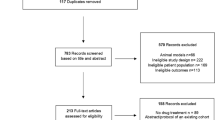Abstract
The exciting news about the US FDA approval of omaveloxolone as the first-ever drug to be approved for an inherited ataxia is welcome news for patients and families that deal with this devastating disease as well as for health care providers and investigators with an interest in this and other rare diseases. This event is the culmination of long and fruitful collaboration between patients, their families, clinicians, laboratory researchers, patient advocacy organizations, industry, and regulatory agencies. The process has generated intense discussion about outcome measures, biomarkers, trial design, and the nature of approval process for such diseases. It also has brought hope and enthusiasm for increasingly better therapies for genetic diseases in general.
Similar content being viewed by others
Data availability
No original data is being reported in this manuscript and none is available.
References
Campuzano V, Montermini L, Moltò MD, Pianese L, Cossée M, Cavalcanti F, Monros E, Rodius F, Duclos F, Monticelli A, et al. Friedreich’s ataxia: autosomal recessive disease caused by an intronic GAA triplet repeat expansion. Science. 1996;271:1423–7.
Babcock M, de Silva D, Oaks R, Davis-Kaplan S, Jiralerspong S, Montermini L, Pandolfo M, JKaplan J. Regulation of mitochondrial iron accumulation by Yfh1p, a putative homolog of frataxin. Science. 1997;276:1709–12.
Delatycki MB, Bidichandani SI. Friedreich ataxia - pathogenesis and implications for therapies. Neurobiol Dis. 2019;132:104606.
Rummey C, Corben LA, Delatycki M, Wilmot G, Subramony SH, Corti M, Bushara K, Duquette A, Gomez C, Hoyle JC, et al. Natural history of Friedreich’s ataxia: heterogeneity of neurological progression and consequences for clinical trial design. Neurology. 2022;99:e1499–510.
Reetz K, Dogan I, Hilgers R-D, Giunti P, Parkinson MH, Mariotti C, Nanetti L, Durr A, Ewenczyk C, Boesch S, et al. Progression characteristics of the European Friedreich’s Ataxia Consortium for Translational Studies (EFACTS): a 4-year cohort study. Lancet Neurol. 2021;20:362–72.
Di Prospero NA, Baker A, Jeffries N, Fischbeck KH. Neurological effects of high-dose idebenone in patients with Friedreich’s ataxia: a randomised, placebo-controlled trial. Lancet Neurol. 2007;6:878–86.
Parkinson MH, Schulz JB, Giunti P. Co-enzyme Q10 and idebenone use in Friedreich’s ataxia. J Neurochem. 2013;126(Suppl 1):125–41.
Qureshi MY, Patterson MC, Clark V, Johnson JN, Moutvic MA, Driscoll SW, Kemppainen JL, Huston J III, Anderson JR, Badley AD, et al. Safety and efficacy of (+)-epicatechin in subjects with Friedreich’s ataxia: a phase II, open-label, prospective study. J Inherit Metab Dis. 2021;44:502–14.
Lynch DR, Mathews KD, Perlman S, Zesiewicz T, Subramony S, Omidvar O, Vogel AP, Krtolica A, Litterman N, van der Ploeg L, et al. Double blind trial of a deuterated form of linoleic acid (RT001) in Friedreich ataxia. J Neurol. 2023;270:1615–23.
Pandolfo M, Arpa J, Delatycki MB, Sang KHLQ, Mariotti C, Munnich A, Sanz-Gallego I, Tai G, Tarnopolsky MA, Taroni F, et al. Deferiprone in Friedreich ataxia: a 6-month randomized controlled trial. Ann Neurol. 2014;76:509–21.
Paupe V, Dassa EP, Goncalves S, et al. Impaired nuclear Nrf2 translocation undermines the oxidative stress response in Friedreich ataxia. PLoS One. 2009;4:e4253.
Anzovino A, Chiang S, Brown BE, et al. Molecular alterations in a mouse cardiac model of Friedreich ataxia: an impaired Nrf2 response mediated via upregulation of Keap1 and activation of the Gsk3beta axis. Am J Pathol. 2017;187:2858–75.
Abeti R, Baccaro A, Esteras N, Giunti P. Novel Nrf2-inducer prevents mitochondrial defects and oxidative stress in Friedreich’s ataxia models. Front Cell Neurosci. 2018:12. https://doi.org/10.3389/fncel.2018.00188.
Lynch DR, Farmer J, Hauser L, et al. Safety, pharmacodynamics, and potential benefit of omaveloxolone in Friedreich ataxia. Ann Clin Transl Neurol. 2019;6:15–26.
Lynch DR, Chin MP, Delatycki MB, Subramony SH, Corti M, Hoyle JC, Boesch S, Nachbauer W, Mariotti C, Mathews KD, et al. Safety and efficacy of omaveloxolone in Friedreich ataxia (MOXIe study). Ann Neurol. 2021;89:212–25.
Lynch DR, Chin MP, Boesch S, Delatycki MB, Giunti P, Goldsberry A, Hoyle JC, Mariotti C, Mathews KD, Nachbauer W, et al. Efficacy of omaveloxolone in Friedreich’s ataxia: delayed-start analysis of the MOXIe extension. Mov Disord. 2023;38:313–32.
Funding
Both authors received research support from Reata Pharmaceuticals to conduct trials that are being commented on in this editorial. No funding was received to support the writing of this editorial.
Author information
Authors and Affiliations
Contributions
Both authors contributed equally to the composition of this manuscript.
Corresponding author
Ethics declarations
Ethical Approval
This paper is an invited editorial comment and does not report any original human or animal research. No ethical committee approval was needed for this work.
Competing Interests
Both the authors of this work were investigators in the pharmaceutical trials being commented on. They received research support from Reata Pharmaceuticals to conduct the trials and also participated in advisory board meetings for the company. DL did not receive compensation for his advisory board participation. There are no non-financial interests to report.
Additional information
Publisher’s Note
Springer Nature remains neutral with regard to jurisdictional claims in published maps and institutional affiliations.
Rights and permissions
Springer Nature or its licensor (e.g. a society or other partner) holds exclusive rights to this article under a publishing agreement with the author(s) or other rightsholder(s); author self-archiving of the accepted manuscript version of this article is solely governed by the terms of such publishing agreement and applicable law.
About this article
Cite this article
Subramony, S.H., Lynch, D.L. A Milestone in the Treatment of Ataxias: Approval of Omaveloxolone for Friedreich Ataxia. Cerebellum 23, 775–777 (2024). https://doi.org/10.1007/s12311-023-01568-8
Accepted:
Published:
Issue Date:
DOI: https://doi.org/10.1007/s12311-023-01568-8




